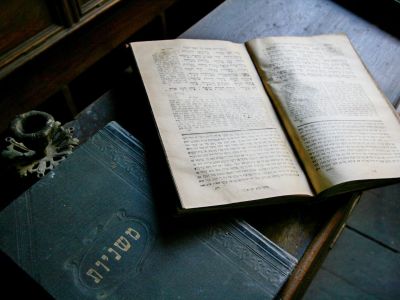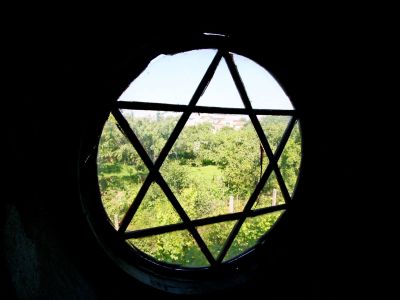Noutati
Synagogue din Caracal
Caracal synagogue was built in 1902, as the inscription outdoor set on building, near the former Hebrew neighborhood. It was built to serve as a place of worship by current Sephardic Hebrew (coming from immigration movement in Spain, Mediterranean areas since 1492 and in 1496 arrived in the Romanian Country).
Construction withdrawn from the street alignment was achieved in local neoclassical architectural style, its achievement is modest exterior, the interior is richly enjoyed the ornaments with painted walls and furniture quality. Patromoniul cultural Caracal in Hebrew, Hebrew Cemetery is maintained.
Hebrew community in Caracal Formation is due to favorable geographic location for development of trade and proximity of large communities evreişti: Ship, Craiova, Calafat. It has a documentary over two centuries and contributed to the urban development of the village. Currently, this community does not have any representative in Caracal.
Historic.
Driven from one country to another and are at the mercy of sovereigns moment, Jews led a wandering life and migratory, as for instance, the great expulsion from Spain.
Mosaic cult existed long Caracal (this we can infer from various historical sources), as confirmed by the presence of two synagogues, the Sergeant Gregory John Street, nr. 2 and one in Hebrew Cemetery.
`40 years of the twentieth century cult breath is amplified by the arrival of Rabbi Simon Scheifestein Caracal.
Unfortunately, after the 80 Jewish spiritual life drops dramatically, leaving most families in Hebrew in Israel, culminating in the cessation of worship, in the XXI century.
Jewish Bible.
Judaism is the oldest religion on earth, of the four fundamental (Old Testament, along with Greek philosophy will be on the foundation of the future religions, Christianity).
Main Hebrew scripture is the Torah (Torat Moshe, the five books of Moses, Pentateuch).
According to Hebrew tradition, Moses (Moche Rabbenu) himself received the entire Torah on Mount Sinai.
In all his books, the Bible, the Torah contains prayers, that expressions of men and women who have experienced a direct relationship between man and God and mysterious.
Torah is the Hebrew scriptures Tanakh structure, which also includes Neviim (Prophets) and Ketuvim (Writings or Hagiografele).
David.
David (1033- 973 BC. BC.) Of the tribe of Judah, will initially only be king in Judea, but around 1000 BC. Hr. Will be able to join Judea (south) with Israel (north).
After another battle with the Philistines and canaaneenii will conquer Jerusalem, setting capital in this city.
It is known as the wise king ( "Psalms of David") and the father of the famous King Solomon, author of "Song of Songs", which will complete the famous temple in Jerusalem.
Synagogue in Caracal.
Caracal synagogue was built in 1902, as the inscription outdoor, situated on the south side of the building:
"Building in 1902, July 2, sub committee composed of d it. President I. Perl, vice president H. Kornbach, controller I. Veintraub, cassier D. Retter, secretary I. Tober members A. Mikhailovsky, S. Leibovici I., A. Veintraub ".
It was built to serve as a place of worship by current Sephardic Hebrew (coming from immigration movement in Spain, Mediterranean areas since 1492 and in 1496 arrived in the Romanian Country).
With rectangular (dimensions: 7,20x 9.40 m) elevation synagogue ground floor comprises, as the main element, the upstairs room and staircase upstairs floor ADOS.
Access the synagogue is carried out through the main entrance, located on the west side and the side opposite the access ladder upstairs.
Roof, tin, culminating in the ultimate symbol of this stately religions: the Star of David.
Downstairs are large windows with three leaves, fitted with wooden shutters. The main entrance has two doors, one inside the window, and the external timber.
First floor windows with deep sills inside, visibly differ from those on the ground floor by their circular form, it appears represented by the Star of David stained glass technique.
On the outside the windows frames in relief, ending up in semicircular shape.
The interior comprises on the ground floor, the basic element of pulpit preaching lectern, disposed in front of the three doors remember the Tabernacle of Moses.
Central door, wood, has a frame in relief, while left and right doors have played mural by painting, drapery element, keeping and they also why the surround.
Access to the room is large pulpit on two wooden stairs with three steps, bordered by a metal railing with discrete neoclassical influences.
The surface on which the pulpit is canted to the rest room.
Above the main entrance, behind the pulpit, is the Star of David, the Hebrew symbol, which is placed Tablets of the Law, the Ten Commandments (Decalogue).
Modernism neoclassicism appears with some rococo touches and pictorial friezes on the walls that complement for the whole combination, (capitals frames of inputs applied over the spindles of spinning here with Romanian traditional connotations).
Dealfel neoclassical, rococo eclecticism fits perfectly on the socio-cultural aspect of Caracalului the time.
Decorative painting, uniting traditional modernism, is operated horizontal strips in vertical compositional boxes fully covered the space generously provided by architecture.
Discover geometric and stylized floral elements, in perfect symbiosis with the blue color of red (the colors that dominate the whole interior).
The furniture, original, and includes wooden pulpit and prayer banks, which are alluring, prayer books.
Interior decoration is achieved through both painting and relief stucco technique, or applied metal.
On the south wall is an inscription that reads:
"Honesty and honor heroes died for their country in the war Hebrew 1916- 1919 (:) goat. David Emanuel, Isaac Amadu, hip. Iancu Weiss, Moritz Lobel, Buca Barat, Solomon Braunstein, Moritz Kimel, Reg. 19th Inf., Iancu Ghinsberg 3 Art. Sr. ".
The floor is wooden.
The first floor is via a side staircase, wooden disposed of the religious right.
Floor floor is not complete, but is cut in the shape of a "U" to the pulpit resting on six metal poles.
Also in the same form of prayer banks are willing and nice numbered.
Decorative Painting, this time deep in neoclassical style, suggesting a stylized architectural element, takes place here in the horizontal direction, interrupted only by the presence of round windows.
Ceiling, semiboltit is entirely painted backdrop depicting the Star of David symbol starry sky.
Starry background is bordered by a railing painted neoclassical somehow reminiscent of the Garden of Eden.
The central ceiling chandelier is suspended metal caught that keeps as little lumânărare a delicate workmanship specified end of the nineteenth century and early twentieth century.
Prof. ref. PhD. Viorel Chirea
Caracal Municipal Cultural Center















